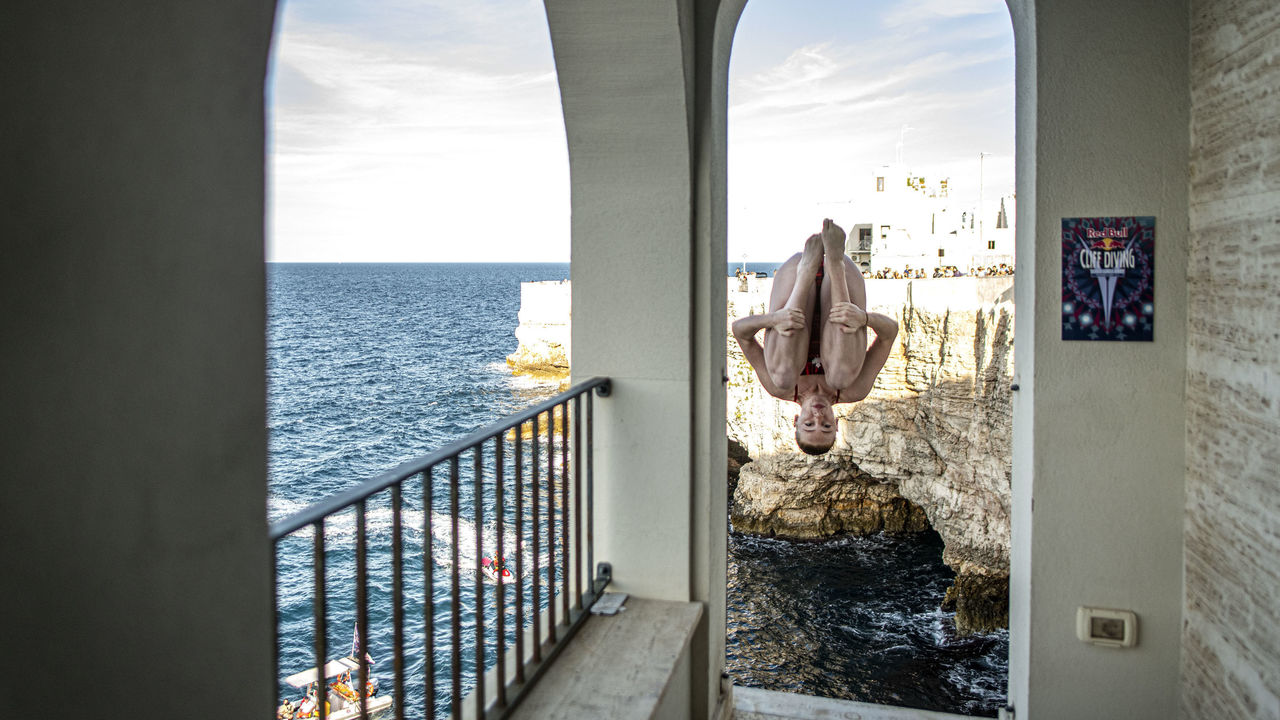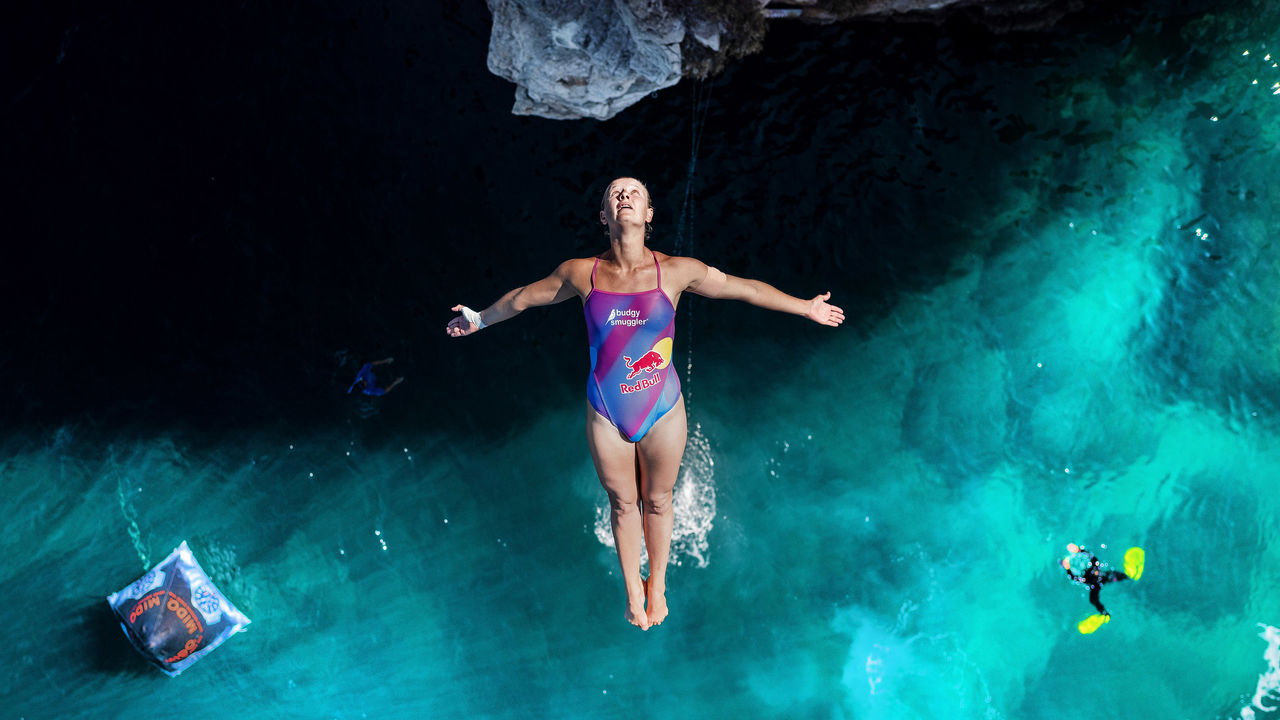These cliff divers travel the world to master 'what shouldn't be survivable'
Molly Carlson stepped to the edge of a 20-meter diving platform in Montreal last summer and questioned the decisions that steered her there. She wondered why she agreed to stand backward at that great height and whether her swim cap made her look "heinous" on camera.
"Just throw your hands and hope for the best," Carlson thought, somersaulting off the board in a TikTok video that she captioned accordingly. "OMG wait. I'm literally flying like an elegant bird."
@mollycarlson My thoughts during a #20Meters dive 🥲 #bravegang ♬ still dont know my name - favsoundds
Carlson has a few million TikTok followers and one career victory in the Red Bull Cliff Diving World Series, the extreme sport's top global competition. Plunging off bridges or the roofs of opera houses, divers contort in front of scenic backdrops - think lakeside mountains or the Eiffel Tower - to land feet-first in open water. Spectators watch from boats as each jump is judged out of 10, reflecting how the divers adapted to the wind and their own jitters.
Cliff divers form an exclusive club. Eight women and eight men are permanent contestants in the worldwide series. An 18th-century Hawaiian chief pioneered the craft that nowadays attracts perfectionists like Carlson, a converted indoor diver from northern Ontario who starred in college at Florida State.
"There's so much fear behind (cliff diving). There are heights. There's danger. If you land wrong, it could be the end," Carlson, 23, said.
"That level of precision and calculated risk is what draws me to the sport. I'm so interested in being able to perform to the level of surviving what shouldn't be survivable. And I'm doing it really well."
Fair point: Carlson is second in the women's standings as midseason approaches, justifying her post-graduation leap of faith. When Carlson polled social media followers on whether she should pursue cliff diving, her mom voted no but "99% of people said yes," sufficient motivation to defer her plan to work as a mental health counselor.


Carlson reached three podiums as a rookie in 2021 and, this June in Boston, stole the spotlight from the sport's five-time reigning champion, Rhiannan Iffland of Australia. Carlson's final jump from a waterfront art museum earned scores of 9.5 and made her the youngest event winner in series history. That held true until her boyfriend, 20-year-old British diver Aidan Heslop, raised the men's trophy less than an hour later.
Carlson trains at Montreal's Olympic pool alongside Jessica Macaulay, the bronze medalist in high diving (Iffland won gold) at the 2019 World Aquatics Championships. Macaulay is British and Canadian and relocated last year to represent Canada, switching affiliations because she was desperate to return to the water during the pandemic.
She dives for the adrenaline rush and to travel widely. Gigs as an entertainer - Macaulay used to dive at a Chinese circus and on a Caribbean cruise ship - prompted her to seek competition on the cliff circuit. She became a two-time season runner-up to Iffland by performing to potential in vibrant atmospheres, like the medieval Italian village the World Series visits in September.
"Whenever we walk up to the platforms, we're walking through the tourist town. The crowd is patting us on the back and yelling for us," Macaulay, 29, said. "We're really lucky to go to some beautiful places. To dive into open water is a really special experience."


Cliff diving's roots date to the 1700s in Hawaii. It's said that the Maui ruler Kahekili, for whom the World Series trophy is named, would regularly leap 200 feet off a rock ledge as a test of courage.
Two centuries later, "Wide World of Sports" highlighted the pastime to a national TV audience. Al Michaels narrated this 1978 event that went down in Acapulco, Mexico.
To replicate Kahekili's no-splash entries, cliff divers have to know where they are while upside down in midair. They descend as fast as 85 kilometers per hour (nearly 53 mph) and flex their limbs and torso to brace for impact. Male divers make sure to cover the groin.
"It's like being sliced in the balls," Gary Hunt, the World Series' nine-time men's champion, recently told Red Bull's in-house magazine.
Hunt and Iffland, who used to train as a trampolinist, dominate cliff diving because they achieve consistency despite the elements. Jumps that a diver executes perfectly indoors are docked points outside when tall waves skew the landing. Competing in the series has convinced Carlson that cliff divers have to learn to accept failure.
"The hardest thing about being a professional athlete is you want the highest level of success at all times. You want to keep pushing. You win something, you've got to win the next one," Carlson said.
"With cliff diving, everything's a gamble. You could be having the best day. You could be having the worst day. You can get unlucky with the wave. At the end of the day, you have to be kind to yourself."


Carlson wants to push boundaries in cliff diving and help spur change. She said the Canadians were the only divers to bring a coach, Stephane Lapointe, to World Series events last season. Other divers now follow suit, she said, a boon for strategy and safety.
Ahead of Saturday's Oslo stop, she planned to tweak a tough dive that she usually performs with her legs tucked, straightening them to increase the degree of difficulty. That poses physical and mental challenges. She's alone on the board with her thoughts until she's airborne, at which point muscle memory kicks in.
"Walking to the edge, all of those negative thoughts come your way. Am I going to be OK? Am I going to remember where to come out (of the dive)? Am I going to do the right amount of somersaults? The right amount of twists?" Carlson said.
"Battling yourself with these emotions, I think that's the toughest part," she added. "If you can outshine fear with truth, you're going to be a magical cliff diver."
Nick Faris is a features writer at theScore.